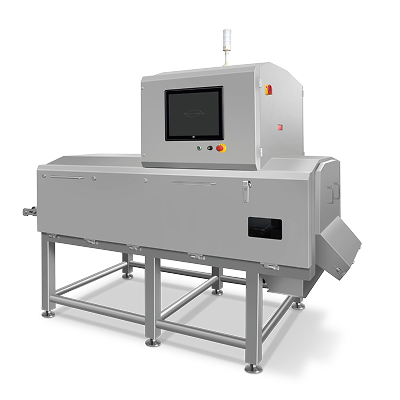Revolutionizing Needle Detection in the Meat Industry: Overcoming Hidden Risks with AI-Powered X-Ray Technology
In the fast-paced world of meat processing, where safety and quality are non-negotiable, even the smallest oversight can lead to significant consequences. From pork chops to beef steaks and lamb cuts, the industry grapples with invisible threats like broken vaccination needles—tiny contaminants that evade traditional detection methods and pose serious health risks to consumers. As global demand for premium, safe meat products surges, processors are turning to advanced technologies to safeguard their supply chains. At RaymanTech, our AI-enhanced X-ray inspection systems are at the forefront of this transformation, offering unparalleled precision in detecting metal foreign objects like needle fragments. This article delves into the persistent pain points of needle detection in pork, beef, and lamb processing, the limitations of conventional tools, and how our innovative solutions deliver superior performance, drawing on the latest industry insights from RaymanTech's meat sector expertise.
The Hidden Dangers: Understanding Needle Residue in Livestock
The journey of a vaccination needle in livestock begins with good intentions—administering essential vaccines to pigs, cows, and sheep to prevent diseases and ensure herd health. However, these procedures are fraught with risks. Animals, driven by instinct, can suddenly thrash or shift during injection, causing the needle to snap. What starts as a millimeter-sized stainless steel shard embedded in muscle tissue becomes a migratory menace. Over time, these fragments can travel from the injection site to adjacent areas, complicating post-slaughter identification. In a 2023 USDA report on meat safety recalls, needle-related incidents accounted for a notable portion of foreign object complaints, underscoring the issue's prevalence.
This isn't just a veterinary concern; it cascades into processing challenges. Residual needles introduce physical hazards, potentially causing consumer injuries like cuts or infections upon consumption. More broadly, they trigger regulatory scrutiny under frameworks like the FDA's Food Safety Modernization Act (FSMA) and HACCP protocols, which mandate rigorous contaminant controls. For processors handling high volumes—think industrial-scale pork facilities churning out thousands of tons annually—these risks amplify operational vulnerabilities, from product recalls costing millions to reputational damage that erodes market trust.
RaymanTech's deep dive into the meat industry reveals that needle fragments are particularly insidious in red meats. Their small size (often under 2mm in diameter) and material properties make them elusive, yet their potential for harm is immense. Addressing this requires not just detection but a holistic approach that integrates safety, quality, and efficiency—core pillars of our whole-chain solutions for bone fragments, metal contaminants, and more.
Why Traditional Metal Detectors Fall Short: Unpacking the "Product Effect" and Beyond
For decades, metal detectors (often called "gold detectors" in industry slang for their ferromagnetic focus) have been the go-to for foreign object detection in meat lines. These devices operate on electromagnetic induction, generating a magnetic field that disrupts in the presence of conductive materials, triggering an alert. While effective for larger ferrous contaminants, they falter spectacularly against needle residues, especially in fresh or frozen red meats.
Consider the anatomy of the problem:
1. Size and Material Challenges: Stainless steel needles, prized for their corrosion resistance in veterinary use, exhibit weak magnetic conductivity. With diameters frequently below 2mm, they produce faint signals that metal detectors struggle to isolate. In contrast to thicker ferrous metals, these shards often slip through undetected, mimicking benign tissue echoes.
2. The Product Effect: Meat's Natural Interference: Fresh red meats like pork, beef, and lamb are rich in moisture, salts, and proteins—ingredients that confer inherent conductivity. This "product effect" generates background noise in metal detectors, akin to static on a radio. As meat density increases (e.g., in bulk packs), so does the interference, drowning out true contaminant signals. Studies from the International Meat Technology Congress highlight how this can lead to false negatives in up to 40% of cases for low-conductivity metals.
3. Orientation Variability: Electromagnetic detection is highly directional. A needle passing horizontally through the field presents a larger surface area, yielding a stronger signal. But in vertical or angled orientations—common due to random tumbling in conveyor systems—the contact is minimal, rendering the signal undetectable. This randomness turns reliable inspection into a game of chance, with detection rates plummeting below 70% in uncontrolled scenarios.
4. Environmental Noise: Processing environments exacerbate these issues. Nearby metals from hooks, trays, or even packaging foils create multi-source interference, confusing the detector's algorithms. Human factors, like inconsistent product orientation, further compound the unreliability.
These limitations aren't theoretical; they're backed by real-world data. A 2024 survey by the North American Meat Institute found that 62% of processors reported needle-related misses with metal detectors, leading to increased manual inspections—costly, labor-intensive steps that slow throughput and heighten error risks. In an era of labor shortages and rising wages, clinging to outdated tech is no longer viable.
RaymanTech's Game-Changing Solution: UHD AI X-Ray for Unrivaled Precision
Enter RaymanTech's Ultra-High Definition (UHD) AI X-ray inspection systems, designed specifically for the meat industry's unforgiving demands. Unlike metal detectors, X-ray technology penetrates product density without bias, visualizing internal structures via differential absorption of X-rays by materials. Our systems, including the Dual-Energy X-Ray for Bone and UHD X-Ray models, elevate this to new heights with AI integration and robust engineering.
At the heart is our UHD detector technology, boasting adaptable resolution that captures sub-millimeter details. Imagine a needle fragment, no matter how fine, rendered in crystal-clear contours against the meat's matrix—something metal detectors can only dream of. This isn't mere imaging; it's empowered by proprietary AI recognition models trained on vast datasets of needle variants across pork, beef, and lamb. These models discern subtle features like edge sharpness and density gradients, achieving detection rates exceeding 99.5% even in complex scenarios.
Hygiene is paramount in meat processing, where cross-contamination can spell disaster. Our IP69K-rated enclosures withstand high-pressure, high-temperature washes (up to 80°C at 100 bar), ensuring seamless integration into wet, high-dust lines without harboring microbes. This hygienic design aligns with EHEDG guidelines, minimizing downtime for cleaning and upholding FSMA compliance.
What truly sets us apart is anti-interference resilience. X-ray inspection ignores the product effect entirely—moisture, salts, and density variations don't mask signals. Needle orientation? Irrelevant; the full 360-degree penetration reveals contaminants regardless of angle. Surrounding metals? Our AI filters them via contextual analysis, reducing false positives by up to 85% compared to legacy systems. In field trials with a major U.S. pork processor, our UHD system identified 1,200 needle fragments in a single shift—fragments that evaded metal detectors—boosting yield by 15% and slashing recall risks.
Beyond detection, our solutions multitask. The X-Ray for Fat Content Analysis variant simultaneously grades fat ratios (critical for ground meat valuation) while scanning for needles, optimizing formulations and reducing waste. Paired with our AI Optical Sorting Systems—like the Medium Speed Sorter for wet environments—these form a seamless whole-chain ecosystem, tackling color defects, shape anomalies, and seal integrity in one go.
Broader Impacts: Efficiency, Compliance, and Market Edge
Adopting RaymanTech's X-ray tech isn't just about dodging needles—it's a strategic upgrade. Processors report 30-50% reductions in manual labor, as automated ejection arms precisely divert contaminants without halting lines. This translates to higher throughput: a beef facility upgraded to our Dual-Energy system saw output rise by 25%, with ROI achieved in under 18 months.
Compliance becomes effortless. Our systems log detailed audit trails, supporting traceability under global standards like ISO 22000. Environmentally, they cut waste—fewer false rejects mean less discarded premium meat—aligning with sustainability goals. For brands, the payoff is a fortified reputation: fewer consumer incidents foster loyalty in a market where 78% of buyers prioritize safety, per a 2025 Nielsen study.
Looking ahead, as automation accelerates, RaymanTech is innovating further. Integrations with IoT for predictive maintenance and edge AI for real-time analytics promise even smarter inspections. We're not just detecting risks; we're preempting them.
Conclusion: Secure Your Chain with RaymanTech
The meat industry's needle detection dilemma is a solvable puzzle, but only with tools that match its complexity. Traditional metal detectors, hampered by physics and variability, leave too much to chance. RaymanTech's UHD AI X-ray systems rewrite the rules, delivering precision, resilience, and efficiency that protect consumers, streamline operations, and elevate quality.
Ready to fortify your meat line? Visit raymantech.us/meat-industry for case studies, or contact us at 717-490-1513 to request a demo. In a world where safety is the ultimate cut above, don't leave fragments to fate—choose technology that sees all.

Related Articles
-
 Nov-18-2025
Nov-18-2025RaymanTech's AI-Powered Multi-Channel X-Ray Solutions for High-Speed Food Safety
In the fast-paced world of food production, ensuring safety, quality, and efficiency is paramount. RaymanTech specializes in AI-driven technologies that address critical challenges in the food, pharmaceutical, and industrial sectors. RaymanTech AI X-ray Inspection System , along with metal detection, checkweighing, and optical sorting , empowers manufacturers to elevate food safety standards while optimizing operational efficiency. At RaymanTech, we understand that modern food production lines demand high-speed, high-volume processing without compromising on precision. This is where our expertise in multi-row, multi-column, and multi-channel X-ray detection shines, transforming industry pain points into opportunities for innovation and growth.learn more -
 Nov-18-2025
Nov-18-2025RaymanTech X-ray Inspection Systems: The Complete Guide to a Smarter, Safer Production Line
When a single shard of glass, a fragment of bone, or an unnoticed plastic tie can trigger a multimillion-dollar recall and shatter consumer trust, food manufacturers can no longer rely on yesterday’s detection technology. RaymanTech has built an entire ecosystem of X-ray inspection solutions that go far beyond traditional metal detectors, delivering density-based, shape-aware, AI-enhanced inspection across every product format imaginable.learn more -
 Nov-18-2025
Nov-18-2025Introduction to RaymanTech Optical Sorters for Farm Products and Food Processors
RaymanTech, as a leading provider of inspection and sorting solutions, has developed a comprehensive optical sorter portfolio that now serves both farm-product applications and food-processing environments. While farm-product sorters focus on capacity, adaptability, and raw-material variability, food-processor-grade sorters must also incorporate high IP protection, robust stainless-steel construction, sanitary design, and harsh washdown compatibility.learn more

Quick Links
Contact
Tel: 717-490-1513
Add: 1050 Kreider Drive -
Suite 500, Middletown,
PA 17057







